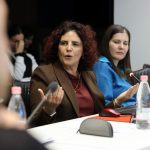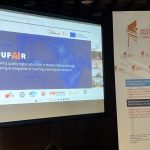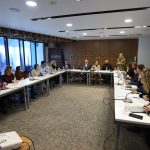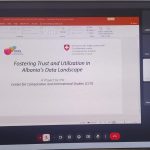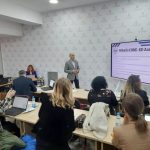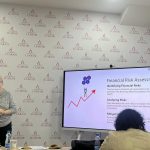CCIS Launches an Innovative Project on Statistics and Governance!
Kick-Off for CORE-ED Academy!
Empowering Albanian Youth: Digital Rights in the AI Era
From: Mr. Alis Ahmetaj
Alis Ahmetaj is a Software Engineering senior student with a strong background in social media strategy and digital communication. Certified in Digital Marketing and an active participant in initiatives such as the Youth European Parliament and Balkan Hacking Initiative, Alis is deeply committed to advancing digital rights and international collaboration.
CCIS YOUTH OBSERVERS
January,2025
In a rapidly digitalizing world, the concept of digital rights has emerged as a cornerstone for empowering young people. In Albania, where a significant portion of the population comprises youth, ensuring equitable access to digital tools, safeguarding data privacy, and fostering active participation in digital democracy are critical. Addressing these issues is not merely a technological challenge; it is a vital step in shaping an inclusive and progressive society.
Albania’s National Youth Action Plan (2023–2025) underscores the importance of bridging the digital divide, but disparities persist, particularly in rural areas. Many young people in these regions face limited access to high-speed internet and digital tools, leaving them at a disadvantage in both educational and professional opportunities. Expanding affordable internet access through public-private partnerships and providing devices to students in underserved areas are practical steps to address this gap. Such measures will not only enhance digital literacy but also contribute to creating a more equitable society.
Despite Albania’s adoption of GDPR-aligned legislation, awareness of data privacy among young people remains alarmingly low. Social media platforms, widely popular among Albanian youth, often exploit user data without transparent consent. This calls for integrating digital literacy programs into school curricula to teach privacy rights and cybersecurity fundamentals. NGOs can also play a pivotal role in launching nationwide campaigns to educate youth on responsible data sharing and the implications of their digital footprints.
Youth engagement in digital democracy is another pressing issue. Platforms like E-Albania and Open Data Albania offer tools for citizen participation, yet many young people find them inaccessible or unappealing. Simplifying these platforms to make them more youth-friendly and incorporating interactive tools like gamified participatory budgeting can foster greater involvement. Such innovations would enable young Albanians to contribute meaningfully to policymaking and hold governmental actions accountable.
Young people in Albania hold immense potential to shape their digital future. They are not just passive consumers of technology but can be powerful advocates for stronger digital rights policies. By developing skills in AI, coding, and cybersecurity through local workshops and online platforms, they can actively contribute to a more inclusive digital landscape. Furthermore, collaborating with policymakers to address issues like digital inclusion and data privacy can ensure that their voices are heard and acted upon.
As Albania continues its digital transformation, significant challenges remain. Bridging the digital divide, strengthening data privacy, and promoting ethical AI practices are essential steps toward creating an inclusive digital environment. However, the journey doesn’t end there. Youth, policymakers, and civil society must work together to build a digital ecosystem where technology serves as a tool for empowerment rather than exclusion.
Investing in digital rights and AI education, Albania can nurture a generation of informed and active digital citizens. These young leaders will not only shape the nation’s digital future but also contribute to a brighter and more equitable tomorrow.
Citations
- National Youth Action Plan (2023-2025)
- GDPR Overview
- UN Guiding Principles on Business and Human Rights
Keywords: Digital Rights, Youth Empowerment, AI
_________________________________________
*This article is produced in the framework of the ERASMUS-YOUTH-2023-CB: A cross regional predictive model for youth policy shaping – Youth Observers. Funded by the European Union. Views and opinions expressed are however those of the author(s) only and do not necessarily reflect those of the European Union or European Education and Culture Executive Agency. Neither the European Union nor the granting authority can be held responsible for them.
© Y-O Model
All rights reserved.
The silent shout of rural youth: Public institutions have failed to listen again*
From: Mrs. Alba Tema
Alba Tema is a young professional in the field of sustainable development of rural areas. She works as Project Officer and Researcher at the Albanian Network for Rural Development and at the same time is the National Coordinator of the Rural Youth Hub Albania.
CCIS YOUTH OBSERVERS
January 10, 2025
For over 30 years, rural youth in Albania have been migrating to urban areas or abroad, in search of better opportunities. According to the Institute of Statistics of Albania, between 2014 and 2023, around 189,734 young people aged 15-35 emigrated, approximately 54% of the country’s total emigrants in this period. Albania is considered a hotspot for youth migration, which has drawn international attention to the phenomenon of brain drain. While migration is a normal process, in Albania, especially in rural areas, it has turned into a persistent exodus that threatens the sustainability of local communities.
Why are rural youth leaving?
The decision to leave often comes from a combination of economic and social factors. Many rural youths seek better living conditions and more stable employment opportunities. In a social cooperative in Cremona, Italy, three Albanian minors from northern rural areas explain their reasons for leaving: “When I turn 18 years old, I will start working… probably in agriculture or maybe in construction. However, I will not pursue any further education. I need to support my family. They depend on me.” Another youngster from Fushe-Kruje, who moved to Cremona years ago, reflected, “Honestly, I don’t plan to return to Albania. I get paid well, and they treat me well here. I don’t think I can build my life in Albania anymore.”
The lack of highs schools near villages and public transportation, as well as low-quality education are other key factors driving youth away from their communities. A youngster in central Albania shared, “I left to study in Tirana 16 years ago. My sister moved from our village when she was 14 years old. This year, my little brother had to leave for a better education. It’s difficult for us to get back to our village; only our parents are staying there.”
But deeper than these socio-economic challenges, young people, especially rural youth often feel unheard, unvalued, and underrepresented. A 19-year-old girl from Hajmel, Shkoder, says, “I have been in Austria and Germany for some months. I am planning to move there. I study informatics, here it’s considered as a work for males. On the other hand, you can work and not be paid well at all. I mean in Shkoder because I haven’t tried it in Tirana.”
The pervasive nature of migration sometimes feels like a societal illness. When I first moved to my new neighborhood in the peripheral part of Tirana, the first thing I noticed was the large houses. However, as days passed, I found myself less surprised by the big buildings and more impressed by the silence around the neighborhood. Conversations with residents revealed more about the tendence of youth to migrate, even though being near to the capital city and have access to services. A woman who runs a small market shared, “I was talking with my son. He is 19 years old and has moved to London. We have our house, this small market… we have everything, but there is better for him. He left like all his friends.”
Rural youth exclusion from youth and rural development policies
The needs of rural youth have been overlooked in national youth policies for a long time. Albania’s National Youth Strategy (2022-2029) outlines a broad framework for youth inclusion, focusing on employment, education, and participation in decision-making. However, it barely addresses the specific needs of rural youth. The strategy mentions rural youth only when it refers to the European Union Youth Strategy (2019-2027), but it doesn’t include any measure that addresses the specific needs of rural youth. On the contrary, the EU Youth Strategy dedicates to rural youth its 6th goal which aims at creating conditions for rural youth to fulfill their potential, by improving infrastructure, offering high-quality jobs, and encouraging rural youth participation in decision-making. Yet, Albania’s National Youth Strategy lacks concrete measures aimed at empowering rural youth.
The Strategy for Agriculture, Rural Development, and Fisheries (SARDF) emphasizes the importance of supporting young farmers. However, while it has proposed some measures aimed at youth in rural areas, these efforts have been insufficient. The SARDF action plan recommended a new initiative for young farmers within the national budget, intended for implementation in 2022-2023. Unfortunately, this scheme has not yet been developed, and rural youth have received minimal support. In contrast, the EU’s Common Agricultural Policy has introduced strategies such as the Complementary Income Support for Young Farmers (CISYF) and other support mechanisms to encourage young farmers in investing in rural areas.
The continuous migration of rural youth in Albania emphasize the failure of public institutions to address their unique needs and aspirations. As they continue leaving in silence their homes in search of a better future, the sustainability of local communities is threatened. It is urgent for policymakers to prioritize the inclusion of rural youth in national development strategies, ensuring that their voices are heard and their potential is fulfilled. Only through comprehensive support and engagement we can reduce migration and encourage rural youth to contribute to the sustainable development of Albania.
_________________________
*This article is produced in the framework of the ERASMUS-YOUTH-2023-CB: A cross regional predictive model for youth policy shaping – Youth Observers. Funded by the European Union. Views and opinions expressed are however those of the author(s) only and do not necessarily reflect those of the European Union or European Education and Culture Executive Agency. Neither the European Union nor the granting authority can be held responsible for them.
© Y-O Model
All rights reserved.
Albania’s Cultural Heritage: A Gateway to Creative Industries and Tourism Development
Prepared by: Nea Xhindi
Ms. Nea Xhindi, a student at Clemson University College of Engineering, Computing and Applied Science, USA, and a fellow at the Center for Comparative and International Studies (CCIS) in Albania, contributed to the Erasmus+ CBHE “DIGITCRESHE“; project, funded by the EU. This article, authored as part of her contractual engagement with CCIS, reflects her commitment and involvement in advancing the objectives of the DIGITCRESHE project, focused on the dissemination of project outcomes and active participation in international activities related to creative industries.
In the framework of the Erasmus +CBHE project “DIGITCRESHE” funded by European Union
Albania, a country blessed with an extraordinary established of cultural and natural assets, is uniquely positioned to use its heritage as a driver of economic growth and international recognition. From its Greco-Roman ruins to Ottoman architecture, from centuries-old religious coexistence to vibrant folklore, Albania’s cultural wealth reflects a storied past that remains relevant to its present. However, while the nation’s cultural treasures are abundant, awareness of Albania’s unique identity on the global stage is still limited. Addressing this gap presents a golden opportunity to position Albania as a key destination for cultural tourism and creative industry innovations.
The synergy between creative industries and tourism offers a powerful tool for revitalizing Albania’s economy. Creative industries, encompassing fields like arts, crafts, digital media, and cultural entrepreneurship, can enrich the tourism experience while creating jobs and fostering innovation. Albania can attract a broad spectrum of visitors—from dedicated cultural enthusiasts to casual travelers seeking memorable experiences by weaving cultural narratives into tourism offerings. Events such as music festivals, craft exhibitions, and interactive storytelling tours in historical sites have the potential to transform Albania into a vibrant cultural hotspot.
Aligning Cultural Heritage with Modern Tourism Demands
Tourism product development must focus on connecting Albania’s cultural offerings with the expectations of diverse visitor groups. Travelers with a deep interest in history and cultural authenticity seek in-depth experiences, such as guided explorations of UNESCO World Heritage sites like Berat and Gjirokastra. Meanwhile, casual tourists benefit from engaging, accessible activities, such as sampling traditional cuisine or attending performances of traditional Albanian polyphonic music. These experiences cater to a spectrum of interests, ensuring that Albania appeals to both niche and broader market segments.
Digital innovation plays a pivotal role in amplifying Albania’s tourism and cultural outreach. Introducing virtual tours of museums, augmented reality experiences in archaeological sites, and online platforms showcasing local artisans can extend the reach of Albania’s cultural assets to global audiences. These tools enable travelers to interact with Albanian culture long before they set foot in the country, sparking curiosity and driving tourism interest.
Sustainability and Community Engagement: A Balanced Approach
Preserving cultural and natural heritage while promoting tourism requires a delicate balance. Local communities should be at the heart of these efforts, benefiting from tourism revenue and actively participating in heritage preservation. Training programs for youth in creative industries, eco-tourism initiatives, and craft cooperatives can empower locals while fostering sustainable tourism practices.
Integrating Albania’s rich biodiversity and landscapes into its cultural narrative enhances the overall visitor experience. The breathtaking mountains, pristine beaches, and historical trails offer opportunities for geotourism, attracting adventurers who seek to connect with nature and history. Highlighting the interplay between Albania’s cultural and natural heritage strengthens its positioning as a holistic destination.
A Path Forward: Strategic Marketing and Global Positioning
As Albania approaches EU membership, the strategic marketing of its cultural heritage becomes a cornerstone of its broader development strategy. A focused campaign targeting travelers with an interest in cultural exploration and meaningful experiences can redefine Albania’s international image. Partnerships with creative enterprises, government support, and private sector involvement are critical in implementing these initiatives effectively.
In conclusion, Albania stands at a crossroads where its rich cultural heritage and modern aspirations converge. the nation can unlock its potential as a cultural hub in the Western Balkans by leveraging creative industries and integrating innovative tourism practices. This journey is not only about attracting visitors but also about fostering pride among Albanians in their cultural legacy and ensuring that this legacy continues to thrive for generations to come.

